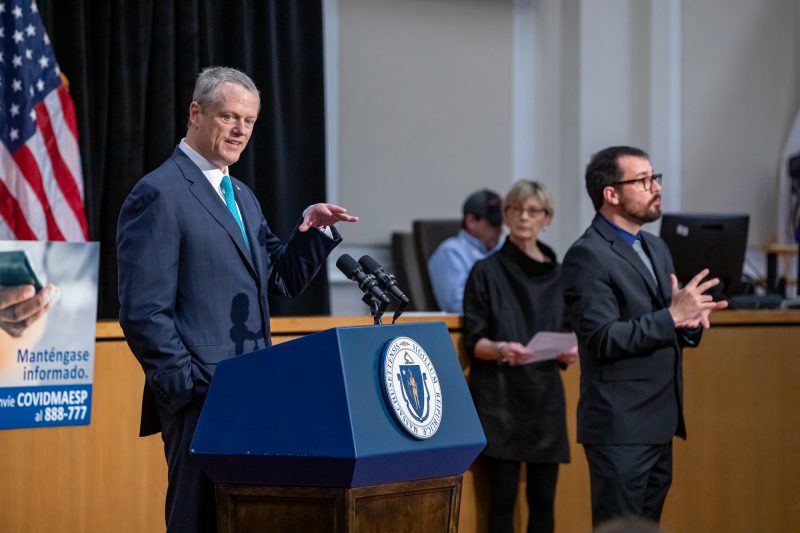Community
Phase II start determined next week; restaurants to open under list of guidelines including outdoor seating

BOSTON – Today, the Baker-Polito Administration provided an update on the Reopening Massachusetts plan and preparations for Phase II. The Administration will determine the start of Phase II on June 6th.
On Monday, Governor Charlie Baker will issue an executive order with a detailed list of sectors that fall into each phase. The order will allow Phase II businesses to bring back employees in preparation for re-opening. Through this order, professional sports teams can begin practicing at their facilities in compliance with the health and safety rules that all the leagues are developing. Facilities remain closed to the public.
Restaurant and Lodging Guidance: The Administration today issued workplace safety standards for restaurants and lodging. These workplace specific safety standards are organized around four distinct categories covering Social Distancing, Hygiene Protocols, Staffing and Operations and Cleaning and Disinfecting.
Restaurants: Outdoor dining will begin at the start of Phase II. Indoor dining will begin later within Phase II, subject to public health data. Even when indoor seating is permitted, use of outdoor space will be encouraged for all restaurants.
Social distancing guidance includes spacing tables six feet apart with a maximum party size of six people. The use of bars, except for spaced table seating, will not be permitted. For hygiene protocols, utensils and menus should be kept clean through single use or with strict sanitation guidelines, reservations or call ahead seating is recommended and contactless payment, mobile ordering or text on arrival for seating will also be encouraged.
Restaurants will be expected to follow cleaning and disinfecting guidelines, in accordance with CDC guidance. This includes closing an establishment temporarily if there is a case of COVID-19 in an establishment.
Lodging: Hotels, motels and other lodging businesses will be allowed to expand their operations in Phase II. Lodging safety standards apply to all forms of lodging including hotels, motels, inns, bed and breakfasts, short term residential rentals including Airbnb and VRBO.
Event spaces, like ballrooms and meeting rooms, will remain closed. On-site restaurants, pools, gyms, spas, golf courses and other amenities at lodging sites may operate only as these categories are authorized to operate in accordance with the phased re-opening plan. Lodging operators also must inform guests of the Commonwealth’s policy urging travelers to self-quarantine for 14 days when arriving from out-of-state.
The full list of restaurant restrictions and guidelines are below:
When indoor table service is permitted, restaurants are encouraged to structure operations to operate as much as possible through outdoor table service and to strictly limit indoor table service in order to assure effective compliance with social distancing requirements and to limit activities within confined spaces.
Restaurants must comply with the following sector specific social distancing rules for providing dining services in all customer seating areas:
•Tables must be positioned so to maintain at least a 6 foot distance from all other tables and any high foot traffic areas (e.g., routes to bathrooms, entrances, exits); tables may be positioned closer if separated by protective / non-porous barriers (e.g., structuralwalls or plexi-glass dividers) not less than 6 feet high installed between tables and high foot traffic areas
•The size of a party seated at a table cannot exceed 6 people
•Restaurants may not seat any customers at the bar, but subject to any applicable building and fire code requirements, bar areas may be re-configured to accommodate table seating that complies with all spacing and other requirements in these COVID-19 safety standards
•All customers must be seated; eat-in service to standing customers (e.g., around bar areas) is prohibited
•Restaurants provide carry-out or delivery service, but all safety standards for table separation, size of party, and hygiene must be maintained for any indoor or outdoor table seating that is available to carry-out patrons
•All other amenities and areas not employed for food and beverage service (e.g., dance floors, pool tables, playgrounds, etc.)must be closed or removed to prevent gathering of customers
Ensure separation of 6 feet or more between all individuals (workers, vendors, and customers) unless this creates a safety hazard due to the nature of the work or the configuration of the workspace:
•Close or reconfigure worker common spaces and high density areas where workers are likely to congregate (e.g., break rooms, eating areas) to allow 6 feet of physical distancing; redesign work stations to ensure physical distancing (e.g., separate tables, stagger workstations on either side of processing lines so workers are not face-to-face, use distance markers to assure spacing including in the kitchen area)
•Establish directional hallways and passageways for foot traffic if possible, to minimize contact (e.g., one-way entrance and exit to the restaurant). Post clearly visible signage regarding these policies
•Prohibit lingering in common areas (e.g., waiting areas, bathrooms) and ensure social distancing in common areas by marking 6feet spacing with tape or paint on the floor and signage
•All customer-facing workers (e.g., servers, bus staff) must minimize time spent within 6 feet of customers
Designate assigned working areas to workers where possible to limit movement throughout the restaurant and limit contact betweenworkers (e.g., assigning zones to servers)
Stagger work schedules and staff meal and break times, regulating maximum number of people in one place and ensuring at least6 feet of physical distancing
Minimize the use of confined spaces (e.g., elevators, vehicles) by more than one individual at a time
Require face coverings for all customers and workers at all times, except where an individual is unable to wear a face covering due to medical condition or disability
Improve ventilation for enclosed spaces where possible (e.g., open doors and windows)
Customers may remove face coverings while seated at tables.
Hygiene Protocols:
All workers must wash their hands frequently, and table servers must wash their hands or apply hand sanitizer between each tableinteraction
Ensure access to handwashing facilities on site, including soap and running water, and allow sufficient break time for workers to wash hands frequently; alcohol-based hand sanitizers with at least 60% alcohol may be used as an alternative
Alcohol-based hand sanitizers with at least 60% alcohol should be made available at entrances, exits, and in the dining area
Supply workers at workplace location with adequate cleaning products (e.g., sanitizer, disinfecting wipes)Post visible signage throughout the site to remind workers and customers of hygiene and safety protocols
Self-serve, unattended buffets, topping bars, drink stations, and other communal serving areas must remain closed
Condiments and similar products (e.g., salt, pepper, and salad dressing) should not be pre-set on tables and should instead only be provided upon request either in single-serving portions (e.g., individual packages or cups) or in serving containers that are sanitized between each use
Menus must be one of the following: 1) paper, single-use menus disposed after each use, 2) displayed menu (e.g., digital, whiteboard, chalkboard), 3) electronic menus viewed on customers’ phones / mobile devices
Utensils and place settings must be either single-use or sanitized after each use; utensils should be rolled or packaged. Tables should not be pre-set to reduce opportunity for exposure
Tables and chairs must be cleaned and sanitized thoroughly between each seating
Staffing and Operations
When possible, reservations or call ahead seating should be encouraged; managers must ensure that diners waiting for tables do not congregate in common areas or form lines
Restaurants may not provide customers with buzzers or other devices to provide alerts that seating is available or orders areready; restaurants should instead use no-touch methods such as audio announcements, text messaging, and notices on fixed video screens or blackboards
Provide training to workers on up-to-date safety information and precautions including hygiene and other measures aimed at reducing disease transmission, including:
•Social distancing, hand-washing, and requirement and proper use of face coverings
•Modifying practices for serving in order to minimize time spent within 6 feet of customers
•Self-screening at home, including temperature or symptom checks
•Reinforcing that staff may not come to work if sick
•When to seek medical attention if symptoms become severe
•Which underlying health conditions may make individuals more susceptible to contracting and suffering from a severe case of the virus
Restaurant operators should establish adjusted workplace hours and shifts for workers to minimize contact across workers and reduce congestion at entry points
Limit visitors and vendors on site; shipping and deliveries should be completed in designated areas
Workers should not appear for work if feeling ill
Restaurants must screen workers at each shift by ensuring the following:
•Worker is not experiencing any symptoms such as fever (100.3 and above), cough, shortness of breath, or sore throat;
•Worker has not had ‘close contact’ with an individual diagnosed with COVID-19. “Close contact” means living in the same household as a person who has tested positive for COVID-19, caring for a person who has tested positive for COVID-19, being within 6 feet of a person who has tested positive for COVID-19 for 15 minutes or more, or coming in direct contact with secretions (e.g., sharing utensils, being coughed on) from a person who has tested positive for COVID-19, while that person was symptomatic
•Worker has not been asked to self-isolate or quarantine by their doctor or a local public health official
•Workers who are sick or feeling ill must be sent home.
Anyone showing signs of illness may be denied entry
Encourage workers who test positive for COVID-19 to disclose to the employer for purposes of cleaning / disinfecting and contact tracing. If the employer is notified of a positive case at the workplace, the employer should notify the local Board of Health (LBOH) where the workplace is located and work with them to trace likely contacts in the workplace and advise workers to isolate and self-quarantine
Notify workers that they may not work if they test positive for COVID-19 (they should be isolated at home) or are found to be a close contact of someone with COVID-19 (they should be quarantined at home)
Testing of other staff may be recommended consistent with guidance and / or at the request of the LBOH. Post notice to workers and customers of important health information and relevant safety measures as outlined in government guidelines
Post notice to workers and customers of important health information and relevant safety measures as outlined in the Commonwealth’s Mandatory Safety Standards for Workplace
Designate the Person in Charge for each shift to oversee implementation of the guidelines in this document
Restaurants will be allowed to maximize outdoor dining space, including patios and parking lots where available, where municipal approval is obtained
When taking reservations and when seating walk-in customers, restaurants should retain a phone number of someone in the party for possible contact tracing





You must be logged in to post a comment Login